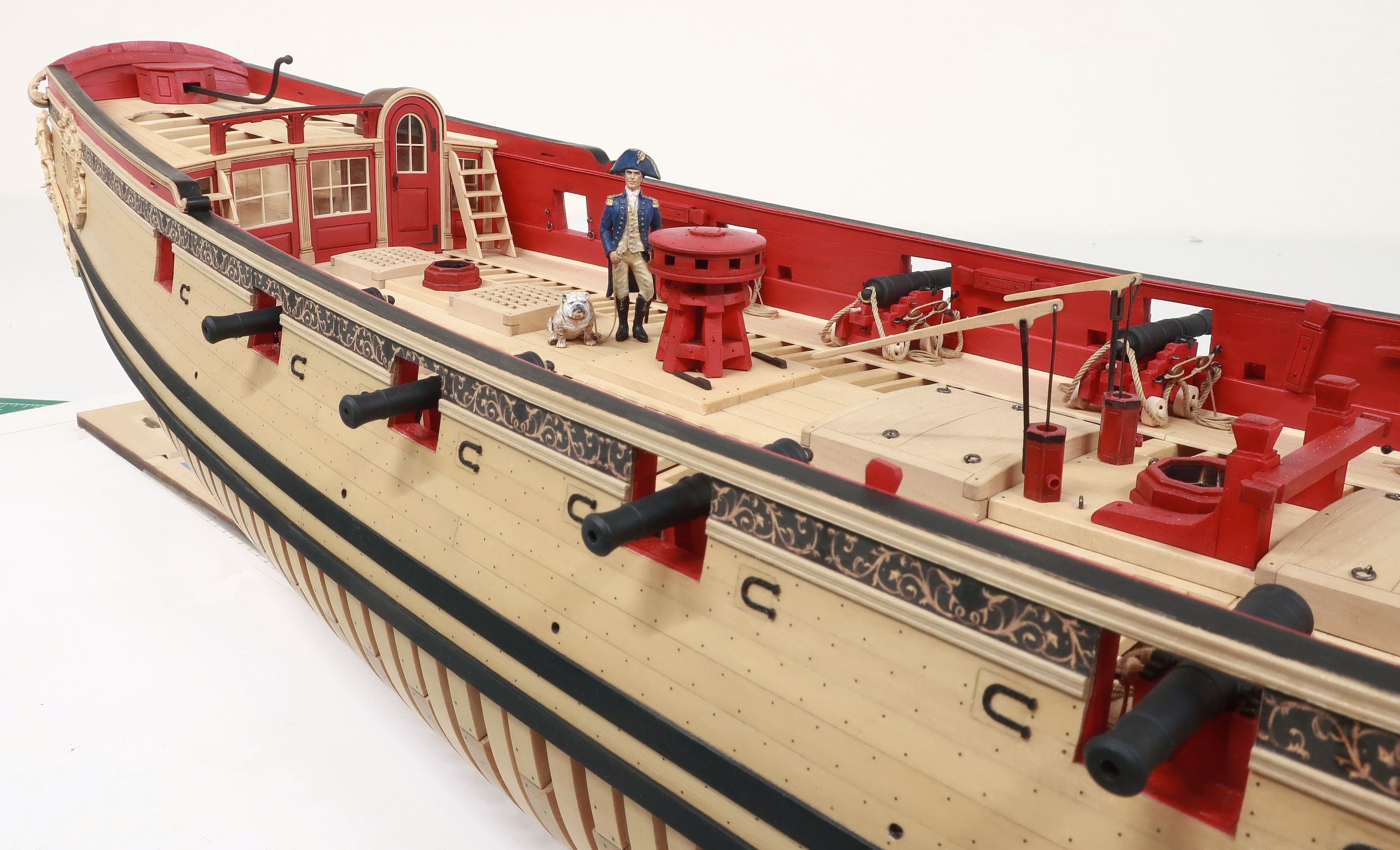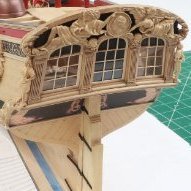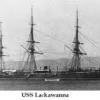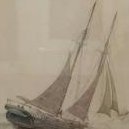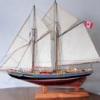-
Posts
9,631 -
Joined
-
Last visited
Reputation Activity
-
 Chuck got a reaction from Rustyj in Cutter Cheerful 1806 by Rustyj - FINISHED - 1:48 Scale
Chuck got a reaction from Rustyj in Cutter Cheerful 1806 by Rustyj - FINISHED - 1:48 Scale
That willmake an excellent workshop. You are doing some great work on Cheerful. I am sure you will be up and running very soon.
-
 Chuck got a reaction from mtaylor in Cutter Cheerful 1806 by Rustyj - FINISHED - 1:48 Scale
Chuck got a reaction from mtaylor in Cutter Cheerful 1806 by Rustyj - FINISHED - 1:48 Scale
That willmake an excellent workshop. You are doing some great work on Cheerful. I am sure you will be up and running very soon.
-
 Chuck got a reaction from Jack12477 in Cutter Cheerful 1806 by Rustyj - FINISHED - 1:48 Scale
Chuck got a reaction from Jack12477 in Cutter Cheerful 1806 by Rustyj - FINISHED - 1:48 Scale
That willmake an excellent workshop. You are doing some great work on Cheerful. I am sure you will be up and running very soon.
-
 Chuck got a reaction from Canute in Cutter Cheerful 1806 by Rustyj - FINISHED - 1:48 Scale
Chuck got a reaction from Canute in Cutter Cheerful 1806 by Rustyj - FINISHED - 1:48 Scale
That willmake an excellent workshop. You are doing some great work on Cheerful. I am sure you will be up and running very soon.
-

-
 Chuck reacted to Rustyj in Cutter Cheerful 1806 by Rustyj - FINISHED - 1:48 Scale
Chuck reacted to Rustyj in Cutter Cheerful 1806 by Rustyj - FINISHED - 1:48 Scale
Hi All,
Continuing on I’ve completed sanding the bulkheads to the desired thickness.
The false deck was cut out of some 1/16” cherry I had on hand. I made it out
of two pieces and after adjusting and fitting it I had a minor gap in the middle
which I filled with wood filler.
Once that was completed I planked the bulkheads and painted it with Red Ochre.
Here you can see that the cap rail has been completed and the margin planking has been started.
That’s the fun stuff.
Well the Admiral and I have purchased a different home and I am now in full
renovation mode. Sadly by the end of this month (April) the workshop will
shut down until the move has been completed and a new workshop constructed.
The new shop will be in a 12x20 section of the basement that is currently unfinished.
So it is going to be a happy/sad time coming up. It will be thrilling to double my
workshop space but shutting down the shop for 3 months or more will really be annoying!
So I will be getting done what I can in between work and the renovations till the end of
the month.
-
 Chuck got a reaction from mtaylor in Biloxi schooner by Russ - FINISHED - 1/48 scale - POB
Chuck got a reaction from mtaylor in Biloxi schooner by Russ - FINISHED - 1/48 scale - POB
Well done and its great to see you working on her again Russ.
-
 Chuck reacted to druxey in Greenwich Hospital barge of 1832 by druxey - FINISHED - 1:48 scale
Chuck reacted to druxey in Greenwich Hospital barge of 1832 by druxey - FINISHED - 1:48 scale
Thanks once more for the likes and comments, everyone.
I had to re-do the side of the coach. I found that I had cut the lights to the wrong depth. In addition, the lights were uneven in width. So, a second round.
When dealing with tiny pieces, I've found it easiest to leave them over-length to glue them on (top photo). I then use a chisel to cut the pieces to exact length. The top and bottom pieces of the panel frame were cut a little overlength, then sanded using a sanding stick to trim them to exact dimension (second photo).
The inner side of the piece has had card strips glued on to leave channels for the glazing (third photo). In this case I shall be using mica. This is a naturally occurring mineral that is fairly transparent. It can be peeled into very thin layers and cuts easily. The pieces will be slid into place from above before the roof is installed. The cutaway at the bottom of the side is because the hull curves inward here and this allows for the changing interior contour.
The last photo shows the work to this point. Next will be the inside panelling and the other side piece.
-

-

-

-
 Chuck got a reaction from russ in Biloxi schooner by Russ - FINISHED - 1/48 scale - POB
Chuck got a reaction from russ in Biloxi schooner by Russ - FINISHED - 1/48 scale - POB
Well done and its great to see you working on her again Russ.
-
 Chuck reacted to russ in Biloxi schooner by Russ - FINISHED - 1/48 scale - POB
Chuck reacted to russ in Biloxi schooner by Russ - FINISHED - 1/48 scale - POB
Here is the nearly completed red bottom. I see from the stern photo, I need to a little touch up around the sternpost. The camera always finds these thing. In any event, it does not look too bad.
Russ
-
 Chuck got a reaction from mtaylor in USS Constitution by xken - Model Shipways - Scale 1:76.8
Chuck got a reaction from mtaylor in USS Constitution by xken - Model Shipways - Scale 1:76.8
Basically to harden the rope....
Before you remove the rope from both sides of the rope walk, After cutting one side only, you stretch the rope.
Dont tug it back and forth. Just give it a gradual gentle pull until it stretches no further. Then hold it there for a few minutes or clamp it there. Do this while you still have control of the rope. If you just cut it free willy-nilly from both ends, and you havent achieved balance from the opposing tensions it will unravel and snake up and get tangled. I am sure this is familiar to many. So this is the opportunity to control the rope as it is still attached to one side of the rope walk. Gradually let it unwind until it no longer untwists. This is the point where you have achieved balance in the opposing tensions. It should hang very nicely.
The opposing tension is what keeps the rope together....twisting all three strands in one direction individually firstvand then twisting all of those strands together in the opposite direction. Its hard to achieve perfect balance. But if you can keep the rope in control after cutting one side free as you let it naturally untwist into balance......you are ready to harden the rope. Hope that makes sense.
I harden the rope by gently stretching and holding it there. When you eventually cut the rope completely free....no twisting and unraveling or snaking together in a tangled mess.
If after you do this, you examine your rope and it is laid up to loosely...it just means you havent put enough initial twists in the individual strands. You didnt build up enough energy and tension so it keeps from unwinding to a loose lay. So the next rope you make should have more tension built up initially in the individual strands . Its trial and error until you discover the proper recipe. But once you do...you can make perfect rope every time..... and very consistently.
Again..this is very hard t do on one of those self-contained automated planetary machines. Finding that balance in tension and hardening is tougher.
-
 Chuck got a reaction from mtaylor in USS Constitution by xken - Model Shipways - Scale 1:76.8
Chuck got a reaction from mtaylor in USS Constitution by xken - Model Shipways - Scale 1:76.8
Ken
Your rope looks great. Well done. Although folks search and search for the best material.....you nailed it.
DMC Corrodent is the best stuff available retail fore rope making. I would still be using it if I didnt want to spend the time dyeing the rope afterwards. There is just too much rope to be made on my end for that. So I get mine custom dyed.
Aunt Lydia's is really lumpy/fuzzy and so is Lizbeths. The later is not even a consistent size. I would stay away from those unless you need to avoid dying as well. The wax wont keep the fuzz down for ever.
The 10 sizes available by DMC make it easy to make any rope size you want. No fuzzies and no lumps. Its really smooth stuff.
Just one tip however. Most folks never twist the rope enough initially when doing the individual strands. The hand crank makes that work hard. I would suggest doubling the initial twists on your rope and this will create a tighter lay of rope.
It just looks better.
I have removed the cranks and use a hand drill on my rope walk as was mentioned. Since getting the laser cutter I no longer use the Expo rope walk. Last three months or so. Its just too cheaply made. I made my own from solid cherry with larger gears. The rope lays up nicer that way. Much Tighter and I now also have four strand capability.
I start with the ends 28 feet apart. Then as the initial twisting occurs the rope walk is literally walked down the table as the thread tightens. For my larger sizes I can walk it as far as 7 feet for the initial twists. Then the three...or in my case sometimes four strands are twisted together on the other end. With my new rope walk I have created a newer rope-recipe for making rope so it lays up even tighter.
DONT FORGET TO HARDEN the rope after you make it. Thats the most important part. See how tightly this rope is laid up......more initial twists are needed to achieve this affect. Since making my own rope walk I have been making it with an even tighter lay to it. This is a photo of my breech ropes with my newer .035 rope. Its four stranded as opposed to three. It allows for a neat little splice simulation on the cannon breech as just wrapping around the button looks so out of scale and clunky.
This is a photo of how I quickly and not being an engineer changed the expo rope walk when I used it. I used this up until three months ago to make all of my rope. It works fine. The principle of rope making is still the same. I am no rocket scientist for sure.... but it beats cranking by hand. As mentioned I can lay up a 20-25 foot length of rope in 5-8 minutes.
-
 Chuck got a reaction from Canute in USS Constitution by xken - Model Shipways - Scale 1:76.8
Chuck got a reaction from Canute in USS Constitution by xken - Model Shipways - Scale 1:76.8
Basically to harden the rope....
Before you remove the rope from both sides of the rope walk, After cutting one side only, you stretch the rope.
Dont tug it back and forth. Just give it a gradual gentle pull until it stretches no further. Then hold it there for a few minutes or clamp it there. Do this while you still have control of the rope. If you just cut it free willy-nilly from both ends, and you havent achieved balance from the opposing tensions it will unravel and snake up and get tangled. I am sure this is familiar to many. So this is the opportunity to control the rope as it is still attached to one side of the rope walk. Gradually let it unwind until it no longer untwists. This is the point where you have achieved balance in the opposing tensions. It should hang very nicely.
The opposing tension is what keeps the rope together....twisting all three strands in one direction individually firstvand then twisting all of those strands together in the opposite direction. Its hard to achieve perfect balance. But if you can keep the rope in control after cutting one side free as you let it naturally untwist into balance......you are ready to harden the rope. Hope that makes sense.
I harden the rope by gently stretching and holding it there. When you eventually cut the rope completely free....no twisting and unraveling or snaking together in a tangled mess.
If after you do this, you examine your rope and it is laid up to loosely...it just means you havent put enough initial twists in the individual strands. You didnt build up enough energy and tension so it keeps from unwinding to a loose lay. So the next rope you make should have more tension built up initially in the individual strands . Its trial and error until you discover the proper recipe. But once you do...you can make perfect rope every time..... and very consistently.
Again..this is very hard t do on one of those self-contained automated planetary machines. Finding that balance in tension and hardening is tougher.
-
 Chuck got a reaction from Jonny 007 in 18th century English Longboat by Chuck - FINISHED - c.1760
Chuck got a reaction from Jonny 007 in 18th century English Longboat by Chuck - FINISHED - c.1760
Next up was to add the cap rail. I like to press a wood sheet against the model and trace the shape of the open hull. Then I add an extra 1/32" to account for the overhang outboard. Then i measure and draw another line inside of that one to create a pattern 1/8" wide or there-abouts. I cut it out on my scroll saw and glue it on. It looks awful at this stage. But then I go back and file the edges so they are uniform outboard and inboard. I tried to create a 3./32" wide cap rail or just a hair narrower than that.
Finally the friezes were added. These were printed on my ink-jet after scanning my master. It was sparayed with some hairspray as a fixative. Once the friezes were in position I used the bottom edge of the paper as a guide to add a strip of 1/32 x 1/32' molding.
Then it was time to paint. The inside was carefully painted as shown in the last few photos above. It was finally starting to look like a boat. Although I like the natural painted planking on the exterior, I thought I would try painting it tallow to match the NMM model. I think it ads some interest so i decided to keep that look although many might prefer to leave planking natural.
-
 Chuck got a reaction from Jonny 007 in 18th century English Longboat by Chuck - FINISHED - c.1760
Chuck got a reaction from Jonny 007 in 18th century English Longboat by Chuck - FINISHED - c.1760
Then it was time to file the center of each bulkhead free. I used a file rather than a saw because I found that the saw teeth pulled the wood and it split the top of the frame. Filing it with gentle pressure was easier for me.
Then the inside of the hull was faired so the frames were quite thin. I noticed a lot of glue smears on the inside of the planking between the frames. This looked sloppy so I used a curved Xacto blade to scrape it clean. It really worked well. Then a coat of Wipe on Poly was brushed on.
-
 Chuck got a reaction from aviaamator in 18th century English Longboat by Chuck - FINISHED - c.1760
Chuck got a reaction from aviaamator in 18th century English Longboat by Chuck - FINISHED - c.1760
To start the planking, I added two strips on each side along the sheer. This stabilized the hull. It was pretty amazing how sturdy the whole thing got. Then I just continued down the hull with a few more. Then I switched directions and started adding them from the keel upwards. I met somewhere in the middle to finish the hull.
The strips were pre-bent to fit the hull both edge-wise and to conform to the bow and stern shape. When it was all done, I added teh stern post. Then it was time to treenail. I treenailed the hull using some Elmers wood filler. To help keep the treenails lined up I used some tape. I ran the tape down the hull being careful to line up one edge on the center of a frame. This was a challenge but I could hold the hull up close to teh light and see through the planking. Then I marked the locations of all of the frames based on the shadows that shown through the planking. I drilled some tiny holes (#78 drill bit) and then filled them. After sanding the hull I applied some wipe on poly
-
 Chuck got a reaction from Jonny 007 in 18th century English Longboat by Chuck - FINISHED - c.1760
Chuck got a reaction from Jonny 007 in 18th century English Longboat by Chuck - FINISHED - c.1760
To start...the slotted false keel was tapered from the bearding line to the outside edge. This created a simulated rabbet once the two keel pieces were cut to shape and glued into position.
Then the 16 bulkhead frames were added. I had these laser cut to save time. They were designed in a way that the center sections are removable. They are held to the frames by small tabs. Once the hull is planks I will file through the tabs and snap out the center sections. Care must be taken to square up the bulkheads with the keel and ensure they are straight so the the proper hull shape can be obtained. You could further stabilize the bulkheads by gluing a temporary batten across the tops of them which will be removed before I start filing the center sections free. But I am not a heavy handed builder so I just started fairing the hull immediately. I use d alight touch while beveling the outside edges of he bulkheads. The transom and bow fillers were added just prior to the start of planking.
-
 Chuck reacted to GLakie in Cutter Cheerful 1806 by rafine - FINISHED
Chuck reacted to GLakie in Cutter Cheerful 1806 by rafine - FINISHED
I wouldn't worry about the "purists" out there Bob. You've been doing a fantastic job on her.
-
 Chuck reacted to russ in Biloxi schooner by Russ - FINISHED - 1/48 scale - POB
Chuck reacted to russ in Biloxi schooner by Russ - FINISHED - 1/48 scale - POB
I know it has been a long time, but I am still working on this schooner. I had to take time to do all sorts of other projects including a large scale model restoration last year. In the meantime, I have been getting a few things done on this model, here and there. Here is where I am at right now.
I am painting the bottom of the hull red. This has a several very thin coats and it will need a few more yet.
I have the sails almost ready. I still need to attach the hanks for the forestaysail and the jib. The main and foresails are both ready to go on the masts right now.
In preparation for rigging, I am making some blocks. Here is the double block for the main gaff halyard.
Russ
-
 Chuck got a reaction from canoe21 in US Brig Syren by _SalD_ – FINISHED - 3/16" scale
Chuck got a reaction from canoe21 in US Brig Syren by _SalD_ – FINISHED - 3/16" scale
Its been so long I am not entirely sure. Tough to remember every last detail. Best to be safe and move it down by at least 1/32" do give you a bit of wiggle room.
Chuck
-
 Chuck reacted to druxey in Greenwich Hospital barge of 1832 by druxey - FINISHED - 1:48 scale
Chuck reacted to druxey in Greenwich Hospital barge of 1832 by druxey - FINISHED - 1:48 scale
Thanks again for all of you who are dropping in on this log.
Further progress sees the completion of the gunwale and its extension aft as a moulding. The aft section of gunwale is 1½" thick, rather than ¾". You can see the step up forward of the cabin area. The moulding section was wet-formed on the plug (lowest photo), then painted and applied to the model. It has a C-curve in one plane and an S-curve in the other.
It was necessary to complete the gunwale before proceeding with the coach sides. I'm now cutting and fitting card pattern pieces for the coach sides.
-
 Chuck got a reaction from Altduck in USS Constitution by xken - Model Shipways - Scale 1:76.8
Chuck got a reaction from Altduck in USS Constitution by xken - Model Shipways - Scale 1:76.8
Basically to harden the rope....
Before you remove the rope from both sides of the rope walk, After cutting one side only, you stretch the rope.
Dont tug it back and forth. Just give it a gradual gentle pull until it stretches no further. Then hold it there for a few minutes or clamp it there. Do this while you still have control of the rope. If you just cut it free willy-nilly from both ends, and you havent achieved balance from the opposing tensions it will unravel and snake up and get tangled. I am sure this is familiar to many. So this is the opportunity to control the rope as it is still attached to one side of the rope walk. Gradually let it unwind until it no longer untwists. This is the point where you have achieved balance in the opposing tensions. It should hang very nicely.
The opposing tension is what keeps the rope together....twisting all three strands in one direction individually firstvand then twisting all of those strands together in the opposite direction. Its hard to achieve perfect balance. But if you can keep the rope in control after cutting one side free as you let it naturally untwist into balance......you are ready to harden the rope. Hope that makes sense.
I harden the rope by gently stretching and holding it there. When you eventually cut the rope completely free....no twisting and unraveling or snaking together in a tangled mess.
If after you do this, you examine your rope and it is laid up to loosely...it just means you havent put enough initial twists in the individual strands. You didnt build up enough energy and tension so it keeps from unwinding to a loose lay. So the next rope you make should have more tension built up initially in the individual strands . Its trial and error until you discover the proper recipe. But once you do...you can make perfect rope every time..... and very consistently.
Again..this is very hard t do on one of those self-contained automated planetary machines. Finding that balance in tension and hardening is tougher.

